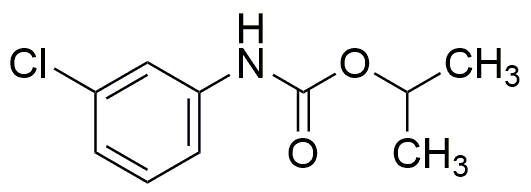Chlorpropham is widely utilized in research focused on:
- Agriculture: It serves as a herbicide to control weeds in various crops, enhancing yield and reducing competition for nutrients.
- Food Preservation: Used to inhibit sprouting in potatoes during storage, it helps maintain quality and extends shelf life, benefiting producers and retailers.
- Research Applications: In laboratory settings, it is employed to study plant growth responses and herbicide resistance mechanisms, providing valuable insights for agronomists.
- Environmental Studies: Chlorpropham is analyzed for its effects on soil health and non-target organisms, contributing to the development of safer agricultural practices.
- Formulation Development: It is incorporated into various agricultural formulations, allowing manufacturers to create effective and targeted herbicide products.
General Information
Properties
Safety and Regulations
Applications
Chlorpropham is widely utilized in research focused on:
- Agriculture: It serves as a herbicide to control weeds in various crops, enhancing yield and reducing competition for nutrients.
- Food Preservation: Used to inhibit sprouting in potatoes during storage, it helps maintain quality and extends shelf life, benefiting producers and retailers.
- Research Applications: In laboratory settings, it is employed to study plant growth responses and herbicide resistance mechanisms, providing valuable insights for agronomists.
- Environmental Studies: Chlorpropham is analyzed for its effects on soil health and non-target organisms, contributing to the development of safer agricultural practices.
- Formulation Development: It is incorporated into various agricultural formulations, allowing manufacturers to create effective and targeted herbicide products.
Documents
Safety Data Sheets (SDS)
The SDS provides comprehensive safety information on handling, storage, and disposal of the product.
Product Specification (PS)
The PS provides a comprehensive breakdown of the product’s properties, including chemical composition, physical state, purity, and storage requirements. It also details acceptable quality ranges and the product's intended applications.
Certificates of Analysis (COA)
Search for Certificates of Analysis (COA) by entering the products Lot Number. Lot and Batch Numbers can be found on a product’s label following the words ‘Lot’ or ‘Batch’.
*Catalog Number
*Lot Number
Certificates Of Origin (COO)
This COO confirms the country where the product was manufactured, and also details the materials and components used in it and whether it is derived from natural, synthetic, or other specific sources. This certificate may be required for customs, trade, and regulatory compliance.
*Catalog Number
*Lot Number
Safety Data Sheets (SDS)
The SDS provides comprehensive safety information on handling, storage, and disposal of the product.
DownloadProduct Specification (PS)
The PS provides a comprehensive breakdown of the product’s properties, including chemical composition, physical state, purity, and storage requirements. It also details acceptable quality ranges and the product's intended applications.
DownloadCertificates of Analysis (COA)
Search for Certificates of Analysis (COA) by entering the products Lot Number. Lot and Batch Numbers can be found on a product’s label following the words ‘Lot’ or ‘Batch’.
*Catalog Number
*Lot Number
Certificates Of Origin (COO)
This COO confirms the country where the product was manufactured, and also details the materials and components used in it and whether it is derived from natural, synthetic, or other specific sources. This certificate may be required for customs, trade, and regulatory compliance.

